Related Research Articles

The Sea Tigers was the naval wing of the Liberation Tigers of Tamil Eelam (LTTE) during the Sri Lankan Civil War. It was founded in 1984. The Sea Tigers had a number of small but effective suicide bomber vessels. During its existence it had gained a reputation as a capable adversary for the Sri Lankan Navy. During the civil war, the Sea Tigers had sunk at least 29 Sri Lankan small inshore patrol boats, 20 Dvora-class fast patrol boats, 3 gunboats, 2 large surveillance command ships, and one freighter.
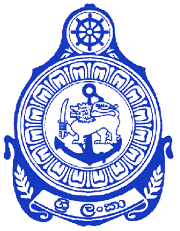
The Sri Lanka Navy (SLN) is the naval arm of the Sri Lanka Armed Forces and is classed as the country's most vital defence force due to its island geography. It is responsible for the maritime defence of the Sri Lankan nation and its interests. The role of the Sri Lanka Navy is to conduct operations at sea for the defence of the nation and its interests and conduct prompt and sustainable combat operations at sea in accordance with the national policies.

SLNS Samudura (P621) is a Sri Lanka Navy Offshore Patrol Vessel. Originally commissioned by the United States Coast Guard in 1968 as the medium endurance cutter USCGC Courageous, she was donated to Sri Lanka in 2004 and commissioned on 19 February 2005.
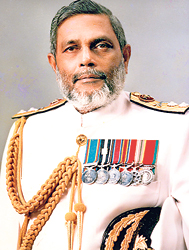
Admiral Wannakuwatta Waduge Erwin Clancy Fernando VSV, USP, MNI was a senior Sri Lanka Navy officer. He served as the Commander of the Sri Lanka Navy from 1 November 1991 to 16 November 1992, when he was assassinated by the LTTE he was the most senior officer in the Sri Lankan armed forces to be killed in the line of duty.
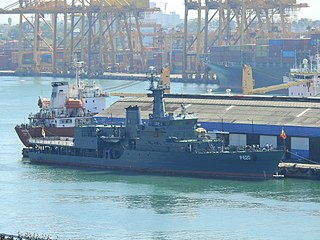
SLNS Sayura is the former flagship and an offshore patrol vessel (OPV) of the Sri Lanka Navy.
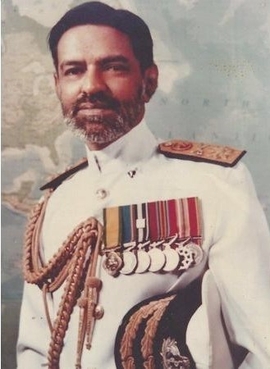
Vice Admiral A. H. Asoka de Silva, VSV was the Commander of the Sri Lanka Navy from 1983 to 1986. He was the first Sri Lankan Ambassador to Cuba.

Admiral Thisara Sugeeshwara Gunasekara Samarasinghe RSP, VSV, USP, ndc, psc, DISS, MNI, SLN was the Commander of the Sri Lankan Navy from 15 July 2008 to 15 January 2011. He had a distinguished 36-year career in the Sri Lankan Navy. His career included a wide range of key appointments at sea and ashore, including training in the United Kingdom, India and the United States.

The Sri Lanka Coast Guard (SLCG) is a Sri Lankan non-ministerial government department tasked with coast guard duties within the territorial waters of Sri Lanka. It comes under the purview of the Ministry of Defence and its members are all naval personnel. The current Director General of the SLCG is Rear Admiral Rajapriya Serasinghe

Admiral Ravindra Chandrasiri Wijegunaratne, WV, RWP and Bar, RSP, VSV, USP, NI(M), ndc, psn, is a retired Sri Lankan admiral, and former Chief of Defence Staff of the Sri Lanka Armed Forces. He has also served as the Commander of the Sri Lankan Navy, Chief of Staff of the Sri Lanka Navy, the Director General of the Sri Lanka Coast Guard and held, at various times, four of the seven Naval Commands of the SLN. Wijegunaratne has also served as Director Naval Operations, and is a recipient of the Weerodara Vibhushanaya.
Sri Lanka Navy (SLN) Dockyard is the largest naval base of the Sri Lanka Navy and a major shipyard located in Trincomalee, Sri Lanka. Established by the British as the Royal Naval Dockyard, Trincomalee, it was home to the East Indies Station of the Royal Navy during World War II. Since the withdrawal of the Royal Navy, the Royal Ceylon Navy took over the dockyard. It became the home base of the RCyN fleet, and today it is home to the Eastern Naval Command and the Naval and Maritime Academy of the Sri Lanka Navy.

Dissanayake Mudiyanselage Sarath Dissanayake is a retired Sri Lankan admiral. Rear Admiral Sarath Dissanayake joined Sri Lanka Navy in 1982 as an officer cadet of the 11th Cadet Intake. During his highly decorated naval career, Rear Admiral Dissanayake served on many ships and in various establishments and imparted his experience and knowledge for the progress of the navy.
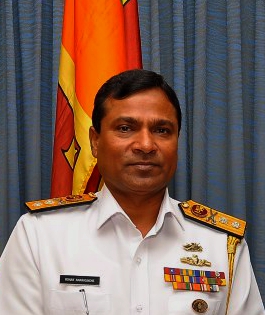
Anthony Rohan Amarasinghe, RSP, VSV, USP, psc, MNI, SLN was a distinguished Sri Lankan admiral. He served as the Director of Naval Rapid Action Boat Squadron, Director Naval Operations, Commander Southern Naval Area (ComSouth), Director General Personnel and Training, Commander North Central Naval Area (ComNorCen), Commander Western Naval Area (ComWest) and Commander Eastern Naval Area (ComEast). He retired from active service in 2014 upon reaching the mandatory retirement age of 55 for Sri Lankan Armed Forces personnel. At the time of his retirement, he was the third most senior executive officer behind Commander of the Navy and the Chief of Staff.

Admiral (retired) Jayantha Perera RWP, VSV, USP, ndu, psc was the 19th Commander of the Sri Lankan Navy.
Vice Admiral Hikkaduwage Ananda Silva, VSV was a Sri Lankan senior naval officer who was the 11th Commander of the Sri Lankan Navy.

SLINEX are a series of naval exercises between the Indian Navy and the Sri Lanka Navy. The first SLINEX exercise took place in 2005. The 11th edition took place in 2024.

Sri Lanka Marine Corps was formed in 2016 under the assistance of the 11th Marine Expeditionary Unit of the United States Marine Corps in November 2016 and received further training from the Commando Regiment of Sri Lanka Army.

SLNS Sindurala pennant number P624 is an advanced offshore patrol vessel (AOPV) of the Sri Lankan Navy. It is the sister ship of SLNS Sayurala.
The Ceylon Royal Naval Volunteer Reserve was the volunteer naval reserve of the British Crown colony of Ceylon from 1938 to 1950. Established as the Ceylon Naval Volunteer Force (CNVF) on 1 January 1938 under the Naval Volunteer Ordinance, No, l of 1937. It was made up of volunteers mainly from the mercantile sector of Colombo consisting of 12 officers and 18 sailors, under the command of the newly commissioned Commander W. G. Beauchamp. The first headquarters of the force was set up on 11 January 1939, just before the outbreak of World War II, at Kochchikade.
References
- 1 2 Jalaldeen, Rafik (7 October 2009). "Lankan-Indian Navies on training exercise". Daily News. Archived from the original on 9 October 2009. Retrieved 16 October 2009.
- 1 2 3 4 Palakidnar, Ananth (11 October 2009). "Cadex-2009 showcases Indo-Lanka Naval rapport". Sunday Observer. Archived from the original on 5 June 2011. Retrieved 16 October 2009.
- 1 2 3 Ferdinando, Shamindra (7 October 2009). "Politics won't hinder Indo-Lanka naval cooperation". The Island. Retrieved 16 October 2009.
- ↑ "Sri Lanka and India Navy conduct joint naval training exercise". Ministry of Defence of Sri Lanka. 6 October 2009. Archived from the original on 29 February 2012. Retrieved 16 October 2009.
- 1 2 Warnakulasuriya, Keerthi (11 October 2009). "යුද රහස් හෙලි කල එන්. ජී. ඕ ක්රියාකාරිකයාගේ සුලමුල හෙලිවේ". Divaina (in Sinhala). p. 18.
- 1 2 Reddy, B. Muralidhar (7 October 2009). "India, Sri Lanka to hold naval training". The Hindu . Archived from the original on 10 October 2009. Retrieved 16 October 2009.
- 1 2 "Indo-Sri Lanka Joint Naval Training Exercise concludes successfully". Ministry of Defence of Sri Lanka. 9 October 2009. Archived from the original on 29 February 2012. Retrieved 16 October 2009.
- ↑ Dias, Supun (7 October 2009). "Sri Lanka and India conduct joint Naval exercises". Daily Mirror. Retrieved 16 October 2009.[ dead link ]
- ↑ "Indian fisherman killed in Lankan firing". IndiaVoice. 13 January 2011. Archived from the original on 21 July 2011. Retrieved 13 January 2011.